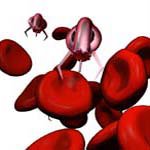“Each one would measure about 1.5cm by 3 cm,” says IPR´s Joerg Seyfried. “They were designed to be complete robots, with different kinds of actuators for gripping, cell manipulation, and so on. Each one would be wireless, with lots of electronics on board, and an infrared control system – rather like a TV remote, but two-way in this case. They would be able to cooperate together on a range of tasks.”
Building the robots involved developing many custom applications, he adds. “One of these was the wireless powering system, the ‘power floor’, which allows the robot to get energy from its surroundings,” he says. “It uses a coil system to transmit the electricity through the air.”
The robots were designed as part of a networked system: “The individual robots are not that intelligent,” explains Seyfried. “They don’t, for example, know where they are, although they know which direction they are moving in. We developed a special positioning system, so that we know where each robot is. It views them from 40 to 50 cm above. They are controlled by a central robot control system, with several networked computers for planning and commands – this could theoretically control many robots.”
The hardest part of the project was “getting the hardware integrated and running – our goal was to have five robots operational, but this couldn’t be done in our three-year timeframe owing to the extreme complexity of the task,” he says.
Nevertheless, the one fully functional robot that the project did achieve could be tested in three different scenarios. “The first was a medical or biological application, in which the robot was handling biological cells, injecting liquid into them,” Seyfried explains. “The second scenario was micro-assembly, in which the robot soldered tiny parts. The final scenario looked at atomic force, with the robot mounting atomic force and doing experiments on it.”
The results were encouraging. “Our experiments showed that the cell injection is entirely feasible, as is the micro soldering,” says Seyfried. Although the MICRON robots are clearly not a mass market product, commercialisation – though still far off – would be perfectly possible, he believes: “Robots with this sort of capability, and mobility, would be perfectly suited to lab work, such as the micro assembly of prototypes. Tasks such as cell injection could be performed on a mass scale.”
With MICRON now having run its course, the project team is currently working on the project reports and evaluation. “What’s missing is the integration work, and this is what we will try to do next within the [also FET-funded] I-Swarm project,” says Seyfried. “This will build on MICRON to produce robots with a ‘swarm’ intelligence – that is, with limited capabilities, but able to communicate with each other.”
The tiny robots of science fiction tales might be smarter, but, as Seyfried points out, “We’re working on the smallest size range currently being worked on by a few other groups worldwide – like MIT. On a European level, MICRON is unique.”
Contact: Tara Morris news@istresults.info 322-286-1985 IST Results
Contact: Joerg Seyfried Institute for Process Control and Robotics Universität Karlsruhe (TH) Kaiserstrasse 12 D-76128 Karlsruhe Germany Tel: +49-721-6083656 Fax: +49-721-6087141 Email: seyfried@ira.uka.de
more at Nano or Chemistry and nanoparticles or atomic level materials and biologically or Nanotechnology and Nanotech or Science and engineering or molecular and medical imaging or nanoscale and Bioengineering or biomedical
Related: Keyword Nanotech Sunday, February 19, 2006 Nanotech to improve health care delivery, Sunday, February 19, 2006 nano-canary in the nanotoxicology coalmine, Sunday, December 04, 2005 Nano-cages 'fill up' with hydrogen, Sunday, November 13, 2005 Testing toxicity of nanomaterials, Sunday, October 23, 2005 single-molecule car, 'Nanocar', Sunday, August 28, 2005 Writing at the nanoscale, Thursday, May 26, 2005 discontinuous palladium, siloxane self-assembled monolayer, Sunday, May 08, 2005 Center for Nanoscale Materials, Monday, April 25, 2005 Nanomagnets, Nanocomposite, Monday, March 21, 2005 porphyrin tubes may lead to new nanodevices, inexpensive hydrogen fuel












No comments:
Post a Comment